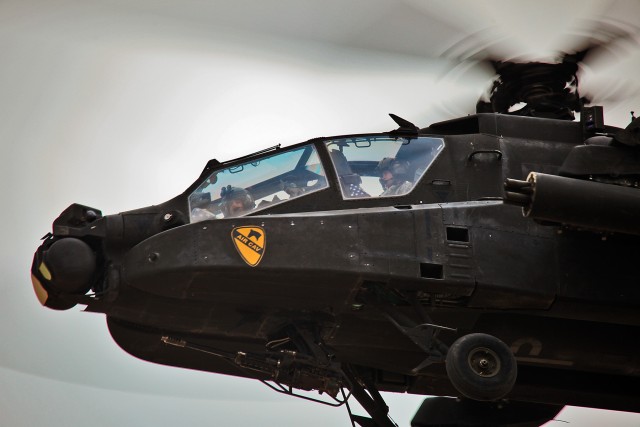CAMP TAJI, Iraq -- A nation's flag can be a powerful symbol of pride for people, but a flag that comes with a story behind it can mean so much more.
From families and friends to companies and organizations, there are numerous people who support the efforts by deployed Soldiers. Support can come in the form of letters, movies, books, snacks and various supplies. It is all done to express the gratitude for what deployed Soldiers are doing in the service of their country.
In an effort to give back, the aviators of the 1st Air Cavalry Brigade, 1st Cavalry Division, are taking American flags on combat missions and then sending them back home to show appreciation for the support.
There are various reasons the aviators take a flag up with them on a mission, whether it is for family and friends, groups they used to be a part of, or for organizations that have given support to the Soldiers deployed, said Capt. Lucas Kennedy, from Kearney, Neb., commander of Company A, 4th Battalion, 227th Aviation Regiment, 1st ACB.
"The flag I am flying today is for a company that has sent us [Morale Welfare and Recreation] type items," said Kennedy. "It is just a way for us to thank them for the movies, candy and personal hygiene products they have sent us."
All of the flags come with a personalized certificate stating the date the flag was flown, what type of aircraft it was flown in, who the pilot was and that it was flown on a combat mission in support of Operation Iraqi Freedom, said Kennedy.
"I hope that these flags we fly are passed down to kids and grandkids, or fly proudly outside a home every day, or up on a wall of an establishment and remain there for as long as that VFW, fire hall or school exists," said Kennedy.
The flags have great symbolism which people can rally around, Kennedy said, and added it is a way for people to remember what was done, making the flag a more powerful item.
In 2003, during the initial push into Iraq, Maj. R.J. Garcia, from South Lake, Texas, the operations officer in charge for 4-227th, came into country with four flags and a plan to distribute them amongst his family.
"I gave one flag to my father, one to another family member, one to a good friend and saved one for my son who was born three days after I got back from that first deployment," said Garcia. "I decided to hold onto the one for my son until I retire, so I could say I flew with it on every combat mission I have ever flown."
"I think the flag is really a universal symbol for freedom; it's really gone beyond being just for Americans, but for the world, and I try to bring that symbol back home for people that do something special for the troops," Garcia continued.
Some aviators use the flag as a way to help people connect with what Soldiers are doing in Iraq.
"Where I come from in Idaho, nobody knows anybody that has been out here (Iraq), so it is kind of nice to be able to share that with them," said Chief Warrant Officer Greg Marotz, from Ashton, Idaho. "We spend 12 or 15 months here and that is a way we can share what we are doing with those that really don't know."
Having sent a flag and certificate back to his junior high and elementary school, the kids were able to see a different side of the war from what is seen on television, and it actually put a face and a story of how the flag came to the school, said Marotz.
The flags that are sent back can become more than just a thank you; the red, white and blue is a common bond for most Americans and these particular flags have a unique beginning.
"It creates a sense of history for people, the flag was actually here in Baghdad and was flown in combat," said Marotz.




Social Sharing